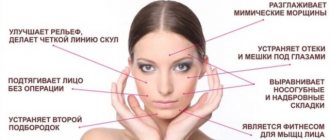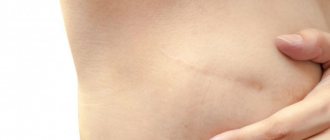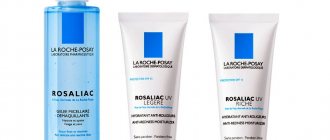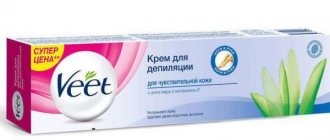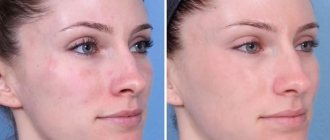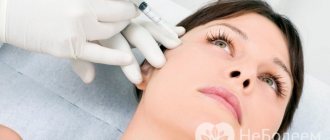Does sensitive epidermis need cleaning: pros and cons
Some people do not even suspect that the discomfort and symptoms that accompany daily skin care procedures are not a manifestation of any dermatological diseases, but simply indicate increased tissue sensitivity. If the epidermis reacts violently to stress, hard water, poor-quality cosmetics, weather conditions, disruption of sleep and rest patterns, then a properly selected peeling or scrub for sensitive skin will quickly reveal its positive properties.
The following factors indicate the benefits of cleaning:
- as a result of a mild but intense effect, metabolic processes are launched, which gradually restore the protective forces of the epidermis. It turns out that the removal of keratinized cells leads to the activation of the regenerative properties of tissues and an increase in skin density.
- Even the most gentle peelings have pronounced bactericidal properties. Often, the increased reactivity of the epidermis is associated precisely with the parasitism of pathogenic bacteria on the surface of the face. It is useless to fight such colonies with water and mild cosmetic products.
- Delicate scrubs completely remove from the skin the remnants of decorative cosmetics, which become clogged in folds and pores, entering into chemical reactions with skin secretions or sweat, causing the development of inflammatory processes.
- timely application of gommage, scrub or peeling for sensitive skin will accelerate the removal of toxins and free radicals. These chemical compounds tend to accumulate in the thickness of tissues, adversely affecting metabolic processes in cells and reducing the level of their protection.
- There is a special type of mites that parasitize human skin, attaching themselves to the mouths of hair follicles and causing the formation of foci of inflammation. Such manifestations cannot be eliminated with daily care; special therapeutic procedures are necessary. For this case, specialists have developed special gentle peelings that can be used even for those conditions that are most often a contraindication to cosmetic interventions.
- even sensitive facial skin needs to control the thickness of the stratum corneum. Refusal to carry out cleansing manipulations can lead to the appearance of a dense crust, which reduces tissue permeability, leading to impaired access of oxygen, and the appearance of problem areas.
Risk factors associated with peeling for sensitive skin:
- Even the most delicate scrubs and gentle peels are highly intense. Abuse of manipulation can lead to thinning of the epidermis and increased severity of aesthetic and physiological problems.
- peeling for sensitive skin is carried out only after preliminary preparation and testing for tolerance of the ingredients. Neglect of safety precautions threatens violent allergic reactions and even the appearance of permanent defects.
- There are not many procedures for caring for reactive epidermis. Incorrectly selected manipulation can worsen the condition of any skin type, and in the case of sensitive epidermis, the formation of combination facial skin is possible, the care of which is considered even more problematic.
- Chemical compositions for sensitive facial skin are quite difficult to choose. Acids of even the lowest concentration can unexpectedly cause chemical burns.
Peeling at home
Peeling is a fairly common skin cleansing procedure. You can buy a ready-made product for this or make it yourself. Although, it’s easier, of course, to purchase a peeling kit in pharmacies, specialty stores and even supermarkets
When choosing, it is important to focus on the composition, expiration date and manufacturer.
What kind of acid is this?
Acid group
There is another name - essence of youth. It has rapid permeability through the upper skin due to its low molecular weight. In cosmetics the concentration ranges from 3 to 10%. For peeling, a concentration of 40% to 80% acid is used.
At home, cleansing with glycolic acid allows you to remove dead skin cells, dirt particles, and toxins through surface treatment of the skin.
Until recently, peeling was done only in beauty salons, but today women can take care of themselves at home using special products and instructions for use.
Action of glycolic acid
- Launches internal processes in the body;
- increases cell regeneration;
- promotes collagen production;
- cleanses;
- reduces sebum production;
- moisturizes;
- smoothes wrinkles;
- has protective properties against ultraviolet radiation;
- reduces pigmentation;
- relieves acne;
- tones.
As soon as the top layer of skin is destroyed, the body starts the process of producing its own collagen. Thanks to this process, the skin is renewed and looks healthy and fresh.
Effect after peeling
It comes on very quickly - within a few hours.
Who is glycolic acid peeling suitable for?
Specialists in beauty salons are confident that such acid peeling is suitable for any skin - both light with freckles and dark. The only difference will be in the concentration of the solution. But, in any case, glycolic acid has a mild effect, affecting only the surface layer of the skin.
Cases when acid peeling can be used:
- after therapy aimed at getting rid of acne, scars, spots;
- in the fight against age-related changes;
- if desired, remove age spots and freckles;
- to remove the top layer of skin;
- to increase skin elasticity;
- pronounced enlarged pores and increased sebum secretion.
In other cases, there is no point in doing an acid glycolic peel. And of course, you shouldn’t expect it to solve problems with scars and deep wrinkles, but it can make them less noticeable. For people over 50 years old, such rejuvenation and cleansing will not be effective, but up to 45 years old it can be safely practiced.
Skin testing
Before starting peeling, it is necessary to check the skin for allergies to the constituent substances. To do this, you need to apply the product to the skin around the elbow or wrist for 10 minutes.
When should the product not be used?
Glycolic acid has several strict contraindications. Among them:
- pregnancy;
- lactation;
- asthma;
- cardiac and vascular pathologies;
- diabetes;
- wounds and inflammations on the skin;
- herpes;
- warts, papillomas and other formations;
- high skin sensitivity;
- allergy to acids;
- fever;
- oncology.
It is not recommended to perform peeling if hair removal or tanning was performed a few days before the procedure.
Undesirable consequences
Side effects appear with a high concentration of acid in the solution, or with prolonged exposure to the skin. It can be:
Swelling that appears a few hours after peeling
It goes away on its own, but requires further caution. Burn with redness. To smooth out the symptoms, you can simply wash your face with cold water and moisturize with a cream with a soothing effect. Allergy
Despite testing before the procedure of applying acid to the face, sometimes it happens that the test was successful, but an allergy appeared during peeling. Then you urgently need to take an antihistamine and further use of acid peeling is prohibited. Increased pigmentation. Dry skin, peeling. To avoid this in the future, it is recommended to dilute the acid even more and be sure to use a rich moisturizer.
What to look for when choosing a peel for sensitive skin
Considering the fact that a peeling or scrub for sensitive skin should be as gentle as possible, first of all, pay attention to the composition of the drug used, the contact medium and the type of manipulation.
Features of chemical peels
- To carry out acid peels, the lowest possible concentrations of reagents are used as a base. If after the first manipulations the benefit is obvious and there are no side effects, then the concentration can be gradually increased until the usual levels are achieved.
- Hard peeling is not suitable for sensitive skin. It is forbidden to rub the components into the skin with force! It is only allowed to apply the composition to the surface of the face in an even layer (multiple layers are also not encouraged) using special tools.
- The time for which a chemical peel is applied for sensitive skin should be reduced compared to standard rates.
- If you decide to carry out peptide or enzyme cleansing, then you should not use fruit acids as a strengthening component. It is better to use delicate scrubs before the procedure, which will increase tissue permeability and stimulate tissue circulation.
- The use of aggressive acids and medicinal components (hydrogen peroxide, calcium chloride, aspirin) is unacceptable!
- Chemical reagents are applied only to the surface of the epidermis that has been previously moistened and protected with a special nutrient medium.
- Medium and deep chemical cleansing can be carried out only according to strict indications, with the permission of a doctor and after a preparatory stage that reduces cell reactivity.
Features of mechanical peelings
- Diamond facial cleansing (with the most gentle attachments), homemade film masks and delicate scrubs made from natural products are the only acceptable means of mechanical action on sensitive facial skin.
- If the integrity of the skin is damaged during cleaning, it is necessary to give the wound maximum care. It must be processed and disinfected. Often, due to oversight, a secondary infection occurs, which leads to long-term rehabilitation.
- Before and after mechanical treatment of tissues, the face must be treated with a moisturizing serum or cream.
- It is recommended to prepare a scrub for sensitive skin yourself. Industrial products contain too many preservatives and dyes that can aggravate the condition of the epidermis.
- Manual mechanical local cleaning of problem areas is acceptable, but in this case increased attention must be paid to sterility.
Features of hardware procedures
- According to modern cosmetologists, hardware cleansing today is one of the most optimal options for caring for sensitive skin. The ability to carry out targeted treatment, control the intensity of the procedure and the depth of cleaning significantly reduces the risks of complications and side effects.
- Before performing any hardware manipulation, a complete examination of the skin must be carried out. The specialist determines the type of problem, the thickness of the stratum corneum and epidermis, and only after that makes a decision on the possibility of conducting a session.
- Hardware peeling for sensitive skin is rarely carried out in standard courses. In this case, more time is required for tissue restoration; the number of procedures is noticeably reduced compared to usual indicators.
The listed rules and recommendations apply not only to salon, but also to home manipulations. Ideally, before starting any therapeutic courses, it is necessary to conduct a full examination of the tissues and obtain advice from an experienced cosmetologist.
Advantages and disadvantages
Jessner peeling has its advantages and disadvantages, which will be discussed further.
The advantages of peeling include the following:
- Relative safety of the technique. The composition used for peeling does not have a deep effect, has high anti-inflammatory effects, is mild to the skin and rarely causes complications.
- Cleansing does not require complex, lengthy preparation or anesthesia; the procedure takes place without severe pain or burning sensation.
- The versatility of the method. You can use Jessner's facial peeling product regardless of the client's skin type and age. In addition, you yourself control the depth of exposure, depending on the degree of the problem and the sensitivity of the skin.
- Pronounced effect immediately after peeling. Patients note a noticeable lifting effect already in the beauty salon.
- Superficial cleaning does not limit the patient in his usual lifestyle. Often, after superficial exposure, peeling as such is not observed, regeneration proceeds gradually, and the patient can go to work or visit.
- Minimum rehabilitation period. Just a week after the mid-peeling, you will be able to enjoy tightened and healthy skin, freshness and beauty of your face.
- Extensive list of indications for cleaning.
- Affordable pricing policy.
- The procedure does not take much time and quickly solves these skin problems.
Unpleasant points for the chosen cleansing method include:
- the presence of contraindications to cleaning, despite the versatility and painlessness of the procedure;
- the risk of developing complications characteristic of chemical cleansing of the integument;
- after the Jessner median peeling, the skin peels a lot, so you may limit your visits to public places;
- the product used for Hollywood peeling has a characteristic, unpleasant odor;
- deep exposure causes pain;
- for those who decide to have a deeper effect on the skin, increasing the number of layers above the proposed one, and also if the peeling technique is violated, the rehabilitation period can drag on for a long period, leading to unpleasant consequences.
Before choosing a cleansing technique, be sure to consult with a specialist, study possible side effects and complications, indications and contraindications, and analyze the feasibility of the procedure in your specific case. What is it, the composition of the product used, how the recovery period proceeds and many other subtleties of the procedure, read on.
Salon treatments for sensitive skin care
If you carry out peeling for sensitive skin in a beauty salon, then first of all it is recommended to pay attention to hardware cleaning:
- Gas-liquid peeling. A stream of air mixed with liquid gently removes horn cells, stimulates the formation of new tissues, improves the resistance of the epidermis to allergens, and evens out the skin texture. If you add certain vitamins to the liquid medium, you can achieve deep hydration. The introduction of anti-inflammatory drugs into the base solution helps prevent the development of infections.
- Oxygen peeling. First, it is recommended to use a scrub for sensitive skin, which will increase tissue permeability. Then the epidermis is exposed to a stream of air. By saturating cells with oxygen, biochemical processes are accelerated, which has a positive effect on the general condition of facial skin and increases tissue resistance to external irritants.
- Ultrasonic peeling. Very gentle and gentle peelings based on ultrasound have several types of positive effects on sensitive skin. The surface of the face is cleansed, contact medium preparations saturate the tissues with everything necessary, multi-level massage stimulates the functioning of blood vessels.
- Reading with liquid nitrogen. Not the most popular peeling for sensitive skin, which, nevertheless, can quickly restore the integrity of the epidermis, relieve it of some aesthetic problems and increase its protective properties.
- Diamond face resurfacing. The type of manipulation that can be used to tidy up areas with the thinnest and most sensitive skin.
Chemical peels:
- Cleaning with lactic or mandelic acid. Very gentle surface-acting peels that smooth the surface of the stratum corneum, stimulate cell function, accelerate epithelization and the formation of a water-lipid layer. To maintain the effect of the procedure, you can sometimes use a natural fruit scrub for sensitive skin.
- Enzyme or peptide peeling. The mildest option for chemical effects on fabrics, which solves problems from the inside. Post-procedure complications or side effects are extremely rare.
- Pearl scrub for sensitive skin. A unique remedy for combating aesthetic problems of the epidermis. To carry out the manipulation, pearl powder is used, which not only has chemical properties, but also acts like a scrub with tiny abrasive particles.
- Herbal scrub or Asian rayon. This procedure can be carried out at home, but for the first session it is recommended to visit a beauty salon. Experienced specialists will select gentle peelings or delicate scrubs, taking into account all the features of the epidermis. The compositions have a double effect, cleansing the surface of the face and stimulating the biological activity of cells.
Efficiency of the procedure
Treatment of rashes is a long process that requires complex therapy, but combining it with a course of peeling will speed up recovery
In fact, 1 procedure is often not enough for a visible result, of course, if we are not talking about deep peeling. Patients note improvements in appearance and velvety appearance, but this is not noticeable to outsiders. And even in photographs the effect after a single session is weakly expressed. Although it is also influenced by a large number of minor factors, supplemented by the individual characteristics of the skin. This is one of the main reasons when women are disappointed in the product, believing that it is not worth the suffering they endure.
Video: Jessner chemical peeling - video report and impressions
Treatment must be carried out in courses with individually calculated intervals - from 1 to 4 weeks. For minor problems or just for cleansing, 3 procedures are enough. If you need to even out the tone, you will need 4-7 visits to the specialist. The decisive factor is the intensity of pigment spots. Regular wrinkles are smoothed out by the 3-6th procedure, but facial wrinkles are a little more difficult. They are considered the most difficult to remove, so one-time peeling is definitely not enough. But post-acne and scars are the slowest to disappear - for pronounced ones, several full courses may be required with a break of 1-2 months.
Possible complications
Still, the Jessner peel is a chemical burn, the only difference being that it is carried out under the supervision of a specialist. Therefore, unpleasant sensations cannot be avoided either during the procedure or during the process of renewal of the epidermis. Another thing is that some of them are considered to be relatively normal, and some are considered serious problems that require treatment. Possible consequences:
- Swelling - can be weak or quite noticeable, appears mainly after 1-2 days. In general, short-term swelling is normal, but in severe cases the face may swell for a week. To prevent this from happening, you need to take into account the structure of the skin, select the correct concentration of acids and the number of layers.
- Partial pigmentation is an individual reaction, but more often spots are the result of neglectful care (lack of SPF, peeling off the skin). Sometimes they go away on their own after some time. Peeling in the autumn-winter period minimizes the risk of hyperpigmentation.
- Painful skin sensitivity. When it appears in the first days after peeling, this is normal. But if the peeling comes to an end, and the discomfort still does not go away, then this is already an alarm bell. It is quite possible that the solution was too strong or the post-peeling period was not carried out correctly.
- Pimples, ulcers, herpes, etc. - becoming covered in red dots after Jessner is not normal. But they may indicate not only a violation of sanitary peeling (care) standards, but also the presence of hidden or chronic diseases. You may need to be treated with antibiotics.
- Allergies occur extremely rarely, because before the main application the product is tested on a small area of skin. But if there are signs of an allergic reaction (not to be confused with burn symptoms), you will need to see a doctor. Suprastin, Cetrin, Diphenhydramine, etc. will help alleviate the condition.
When performing a Jessner chemical peel at home, you need to be extremely careful - even a small application mistake can lead to serious consequences.
Popular and effective home care techniques
Regular and complete care for skin prone to increased reactivity at home is the key to a quick and noticeable improvement in the condition of the epidermis. It is better to leave finished cosmetic products to professionals. A peeling or scrub for sensitive skin, created industrially, will provide quick one-time care, often leading to deterioration of the condition of the tissue in the future. The availability of natural components with therapeutic properties allows you to independently create effective and safe drugs.
There are two folk remedies that can quickly transform the appearance of both facial skin and its texture.
Citrus peeling for sensitive skin
Dry the dried peels of lemon, orange, grapefruit or tangerine and grind them in a coffee grinder to flour. The resulting powder is diluted with a fermented milk product of your choice. The higher the sensitivity of the epidermis, the lower the acidity of the contact medium should be. Usually kefir or sour cream is used. The consistency is selected independently. Apply the resulting composition to the skin in a generous layer and wash off after 10 minutes. Such gentle peels cleanse the surface of the face, moisturize and nourish cells, restore the normal texture of the epidermis, and increase its resistance to weather conditions, ultraviolet radiation and microbes.
Soft scrub for sensitive skin
Take equal quantities of almond kernels and oatmeal, grind the components in a coffee grinder or blender to a coarse flour. Add a little cream, brewed green tea, a couple of drops of rose oil. The product should be thick and homogeneous. Let it sit for half an hour. We wash our face with chamomile decoction and do not wipe it off. We wet our hands in the same decoction, take a little mixture, rub it in our palms and apply it to the skin of the face with gentle massaging movements. After a couple of minutes of massage, the composition can be washed off or left for ten minutes as a mask. If such delicate scrubs are used once every two weeks, you can completely get rid of the problems typical of sensitive skin in just a couple of months.
Contraindications and precautions
The procedure cannot be performed if:
- there are inflammatory processes on the skin;
- for psoriasis, herpes;
- with dilated vessels;
- for scratches, microcracks, wounds;
- in case of allergic reactions to some components;
- if you have acne on your face.
The following procedures are also contraindicated in the salon:
- pregnant and lactating women;
- if liver or kidney failure is detected;
- for pathologies of the cardiovascular system;
- for mental disorders.
After peeling, it is recommended to use sunscreen for a week before going outside, regardless of the time of year.
It is also recommended to use a moisturizer that contains aloe vera several times a day.
Gentle facial peeling and following the recommendations will allow women to look amazing at any age.
Results of using natural and professional peelings and scrubs
A properly selected and timely peeling or scrub for sensitive skin can provide the following results:
- Tissue conductivity will improve without aggressive procedures or compromising the integrity of the skin. Creams and serums will be evenly distributed and absorbed well, providing the most positive effect.
- Delicate scrubs allow you to even out the relief of the skin, get rid of signs of aging, stretch marks, and sagging tissue.
- Skin density will increase, tissue resistance to adverse external conditions will improve.
- As a result of normalization of blood vessels, complexion will improve, congestion and infiltrates will disappear.
- Neutralizing the effects of pathogenic microbes and toxins will lead to a noticeable improvement in cell function and smoothing out the texture of the epidermis.
- Any peeling and scrub for sensitive skin restores tissue respiration, normalizing the flow of oxygen to cells. As a result of the normalization of oxidative processes, the synthesis of collagen and elastin is accelerated, which leads to noticeable facial rejuvenation.
If, as a result of regular use of drugs, tissue sensitivity only increases, it is necessary to abandon the type of current exposure and try something else. If tissue pain occurs, it is recommended to consult a dermatologist to rule out skin or systemic diseases.
Features of caring for sensitive skin
Proper care for sensitive facial skin is not only delicate scrubs and gentle peels, but also proper daily manipulations. In order for the tissue condition to gradually improve, it is recommended to follow the following rules:
- Water for washing must be softened, filtered or boiled. The best option is to use herbal decoctions. After them, the use of decorative cosmetics will not cause such a violent reaction and peeling for sensitive skin will demonstrate its properties better.
- To ensure that a scrub for sensitive skin does not damage the tissue, before starting the manipulation, the face must be moistened with water, a herbal decoction or a very light cream that does not form a film.
- To maintain the effect obtained after salon procedures, it is recommended for some time to use specialized products of the same brand that were used during cleansing.
- You should not change your usual peeling for sensitive skin to more aggressive options if noticeable improvements appear. You can change the product only if the manipulation no longer gives the desired effect. This indicates an improvement in the protective functions of tissues.
- The scrub for sensitive skin is recommended to be used only when indicated. Any mechanical impact on the tissue can negatively affect the condition of the epidermis and lead to increased symptoms.
- If increased sensitivity of facial skin is a consequence of pregnancy and the hormonal changes in the body caused by it, it is recommended to be patient and wait until the factor ends. Attempts to neutralize the condition may lead to nothing and may even worsen the situation. And during such a period, the skin just needs to be “pampered” more often with soothing compresses.
